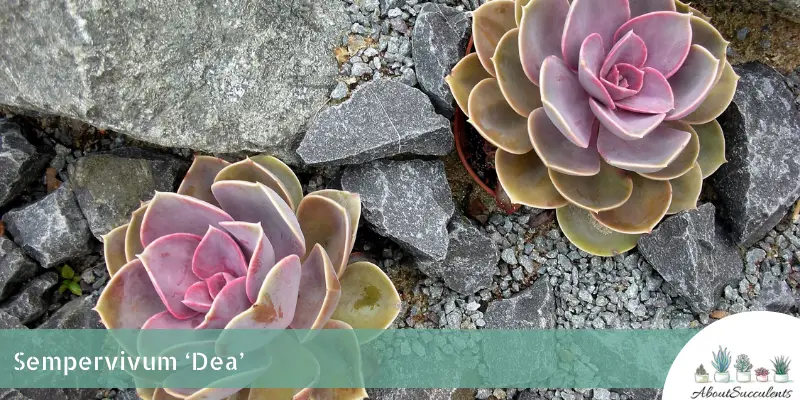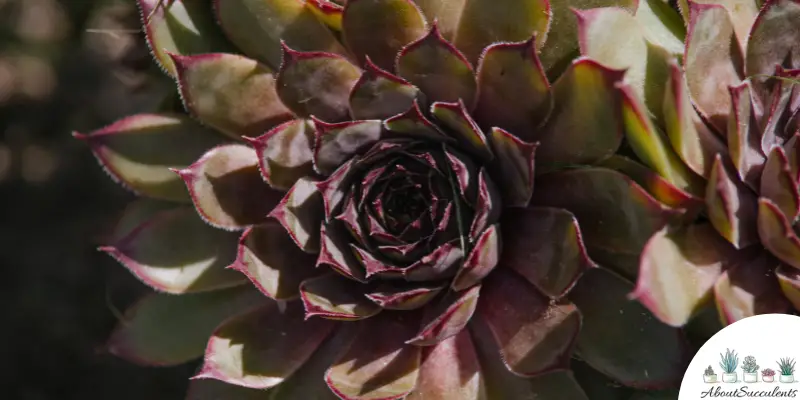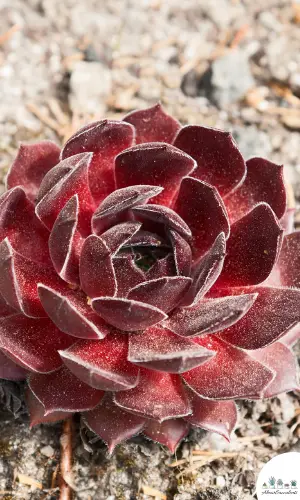
Sempervivum Dea is a type of succulent that’s rising in popularity because of its thick and plump leaves that vary in color – burgundy, pink, or green depending on the season.
The leaves form a symmetrical, tightly-packed rosette that creates a mesmerizing effect with the colors seemingly changing as you get closer to the center. The rosettes bloom up to 12-inches (30.5cm) wide and 4-inches (10cm) tall.
Every spring, Sempervivum Dea grows offsets that are beautifully spread out at the base of the mother plant like little chicks. For this reason, Sempervivum Dea was given different nicknames such as “Hens and Chicks”, “Houseleek”, and “Live Forever”.
While Sempervivum Dea was given the alias “Live Forever”, growers need to know that this is a monocarpic succulent, meaning it only blooms once in its lifetime. It grows for many years and produces many offsets before blooming. Once the flower blooms, the mother plant dies.
This succulent makes a great addition to a rock garden, miniature indoor landscape garden, dish garden, and green roof.
Hen and Chicks are so prolific and resilient that they can thrive even in unusual places like cracks in the wall, between rocks, or hollow spots in trees.
Sempervivum Dea is native to Europe and North Africa. It belongs to the Sempervivum genus of the Crassulaceae family.
General Information
Also known as: Hen and Chicks, Live Forever, Houseleek
Plant Family: Crassulaceae
Origin: Hybrid
Height: 5-10 cm (2-4”)
Exposure: Partial Shade or Full Sun for up to 6 hours
Water Needs: Extremely drought tolerant; apply the “soak and dry” watering method where you give the soil a thorough soaking once it’s been tested as 100% dry.
Soil Type: Gritty, cactus or commercial succulent soil mix with added perlite, pumice, and coarse sand for improved drainage.
Soil pH: 6.0
How To Grow And Care For Sempervivum ‘Dea’

‘Hen and Chicks’ are very easy-to-care-for and a perfect choice of succulent for novice growers. It is best grown outdoors to provide ample space for the chicks to spread out and blanket the ground.
Many succulent growers use Sempervivum Dea to cover their roofs because they can thrive there with little care. They can also be grown indoors in potted containers or shallow planters on sunny windowsills.
In Europe ‘Houseleeks’ are traditionally planted on the roofs of cottages. According to folklore, having a mat of ‘Hen and chicks’ on your roof will protect the dwellers from lightning and fire.
If you are planning to create a green roof, Sempervivum Dea is a great choice because they can quickly multiply with little care and on shallow soil.
Sempervivum Dea is a frost-hardy succulent and can survive at temperatures as low as -29°C (-20°F). It can thrive under a blanket of snow without losing its vibrant hues.
Sunlight
Place your Sempervivum in an area where it could get 6 hours of full or filtered sunlight every day. Good exposure to light will allow its vibrant hues to come out.
Avoid exposing your succulents to extreme heat to prevent sunburn and wrinkled leaves. If potted, place it in a partially shaded area during midday. If planted outside, provide a shade to shield it from intense light.
Insufficient sunlight exposure causes etiolation, where the plant loses its shape and elongates. This is common for indoor plants, so make sure to place your pot in an area where your plant can bask in the sunlight for 6 hours.
If there aren’t areas inside your home that can provide a good amount of sunlight, place Live Forever under a Grow Light for the required number of hours.
Watering

Keeping a tight watch on its watering schedule is very important to keep Sempervivum Dea healthy and happy. Like other succulents, it’s better to water Live Forever less than more.
Overwatering will prolong moisture in the soil which isn’t good for the roots. To know for sure that the soil needs water, test its level of dryness first. You can do this with your hand or a stick.
If the soil is dry to the touch, then it might be alright to give it water. However, a more accurate method is to insert a stick an inch into the topsoil. If the stick feels dry, then you can give the soil a thorough soaking. The soil tends to dry out faster in the summer and slower in the winter.
Pot and Soil
Sempervivum Dea can grow happily in terracotta and ceramic pots. These are made of breathable materials which are ideal for soil aeration. Buy pots with drainage holes to allow the soil to dry out properly.
Choose the right size of the pot to provide the roots with enough room to grow and enable good air circulation in the soil. If you bought a 2-inch (5.08cm) wide Sempervivum Dea, get a 3-inch (7.62cm) wide pot.
For your potting soil, use a well-draining soil mix such as cactus or succulent soil mix. Combine it with plenty of gritty materials such as pebbles, perlite, pumice, and crushed limestone. 3 parts soil to 1 part grit is a good combination ratio.
Fertilizer is not needed but will not harm Sempervivum Dea if given during the growing season. For indoor succulents, fertilizing the soil is a good idea to improve its level of nutrition. Make sure the fertilizer is diluted with enough water to lower its potency to only 25%.
How To Propagate Sempervivum ‘Dea’
When planted outdoors, Sempervivum Dea can be left alone to grow into mounding clusters. You can also propagate them by hand to increase your potted collection or create your green roof. Unlike other succulents, Sempervivums cannot be propagated using leaf cuttings.
You can only propagate Sempervivums by using its offsets or ‘chicks’ on stolons. The best time to do this is during spring or summer.
Step 1: Gently pull a well-rooted offset or ‘chick’ from the mother plant. You can also use a sterile knife or garden shears to cut the ‘offset’.
Step 2: Gently remove the soil from the roots. Place the offsets in a cool and shaded area. Allow them to dry for 1-2 days.
Step 3: Place the offset in the pot and spread the roots out. Fill the pot with well-draining soil. Water the plant 7 days after you have repotted it.
Frequently Asked Questions
Is Sempervivum ‘Dea’ Toxic For Cats And Dogs?
Sempervivum Dea is not listed as toxic to cats and dogs on the website of the American Society for the Prevention of Cruelty to Animals. (ASPCA)
Why Is My Sempervivum ‘Dea’ Dying?
If your ‘Hen and Chicks’ start to look unwell, your plant’s illness may be caused by the following:
Overwatering
Overwatering is the number one killer of succulents. When the soil gets too clogged with water, bacteria and molds start to breed and harm the roots of your succulents.
You need to start treating your plant as soon as you see signs of root rot such as wrinkly, dull green, or yellow leaves. Repotting your Sempervivum Dea is necessary to restore the health of your plant.
Gently remove your plant from the pot and shake off the soil from the roots. Use a sterile knife or razor blade to cut off the damaged roots. Leave the plant in a cool, dry, and shaded area.
Fill a terracotta or ceramic pot with succulent soil mix combined with gritty materials. Repot your ‘Hen and Chicks’ and wait for 7 days before you water the soil.
Pest and Infestation
Sempervivum Dea is prone to mealybug infestation. If the soil is infested with these pests, treat it with neem oil or isopropyl alcohol as a soil drench.
Mix 1 tablespoon of neem oil, 1 teaspoon of dish castile soap, and 1 quart of warm water. Use this mixture as a soil drench or plant spray every week until the mealybugs are gone.
If the mealybugs have infested the leaves only, wipe the leaves with cotton drenched in 70% rubbing alcohol. Use cotton swabs to reach the inner crevices of the rosettes. Treat your plant once a week until the pests are gone.
Yes, Sempervivum Dea produces scentless flowers on a stalk once in its lifetime. Short spikes of pink or yellow blossoms appear at the center of the plant when the rosettes are due for blooming.
‘Live Forever’ does not bloom until after several years. Once it blooms during the spring or summer, the flower remains for a week or more. When it dies, the mother ‘hen’ will follow suit.
Last Updated on June 9, 2022 by Sofia Lara